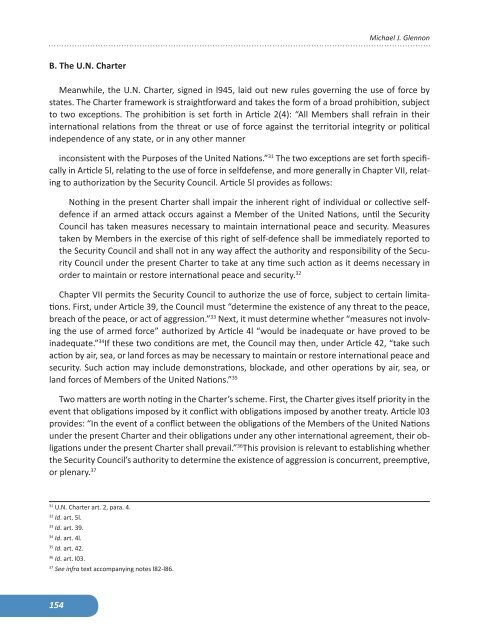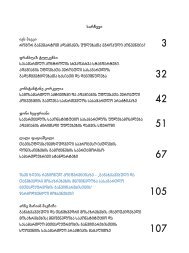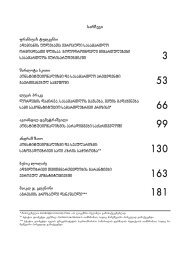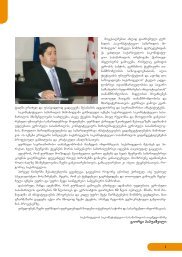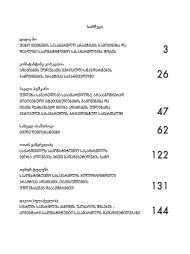Contents - Constitutional Court of Georgia
Contents - Constitutional Court of Georgia
Contents - Constitutional Court of Georgia
You also want an ePaper? Increase the reach of your titles
YUMPU automatically turns print PDFs into web optimized ePapers that Google loves.
B. The U.N. Charter<br />
154<br />
Michael J. Glennon<br />
Meanwhile, the U.N. Charter, signed in l945, laid out new rules governing the use <strong>of</strong> force by<br />
states. The Charter framework is straightforward and takes the form <strong>of</strong> a broad prohibition, subject<br />
to two exceptions. The prohibition is set forth in Article 2(4): “All Members shall refrain in their<br />
international relations from the threat or use <strong>of</strong> force against the territorial integrity or political<br />
independence <strong>of</strong> any state, or in any other manner<br />
inconsistent with the Purposes <strong>of</strong> the United Nations.” 31 The two exceptions are set forth specifically<br />
in Article 5l, relating to the use <strong>of</strong> force in selfdefense, and more generally in Chapter VII, relating<br />
to authorization by the Security Council. Article 5l provides as follows:<br />
Nothing in the present Charter shall impair the inherent right <strong>of</strong> individual or collective selfdefence<br />
if an armed attack occurs against a Member <strong>of</strong> the United Nations, until the Security<br />
Council has taken measures necessary to maintain international peace and security. Measures<br />
taken by Members in the exercise <strong>of</strong> this right <strong>of</strong> self-defence shall be immediately reported to<br />
the Security Council and shall not in any way affect the authority and responsibility <strong>of</strong> the Security<br />
Council under the present Charter to take at any time such action as it deems necessary in<br />
order to maintain or restore international peace and security. 32<br />
Chapter VII permits the Security Council to authorize the use <strong>of</strong> force, subject to certain limitations.<br />
First, under Article 39, the Council must “determine the existence <strong>of</strong> any threat to the peace,<br />
breach <strong>of</strong> the peace, or act <strong>of</strong> aggression.” 33 Next, it must determine whether “measures not involving<br />
the use <strong>of</strong> armed force” authorized by Article 4l “would be inadequate or have proved to be<br />
inadequate.” 34 If these two conditions are met, the Council may then, under Article 42, “take such<br />
action by air, sea, or land forces as may be necessary to maintain or restore international peace and<br />
security. Such action may include demonstrations, blockade, and other operations by air, sea, or<br />
land forces <strong>of</strong> Members <strong>of</strong> the United Nations.” 35<br />
Two matters are worth noting in the Charter’s scheme. First, the Charter gives itself priority in the<br />
event that obligations imposed by it conflict with obligations imposed by another treaty. Article l03<br />
provides: “In the event <strong>of</strong> a conflict between the obligations <strong>of</strong> the Members <strong>of</strong> the United Nations<br />
under the present Charter and their obligations under any other international agreement, their obligations<br />
under the present Charter shall prevail.” 36 This provision is relevant to establishing whether<br />
the Security Council’s authority to determine the existence <strong>of</strong> aggression is concurrent, preemptive,<br />
or plenary. 37<br />
31 U.N. Charter art. 2, para. 4.<br />
32 Id. art. 5l.<br />
33 Id. art. 39.<br />
34 Id. art. 4l.<br />
35 Id. art. 42.<br />
36 Id. art. l03.<br />
37 See infra text accompanying notes l82-l86.


